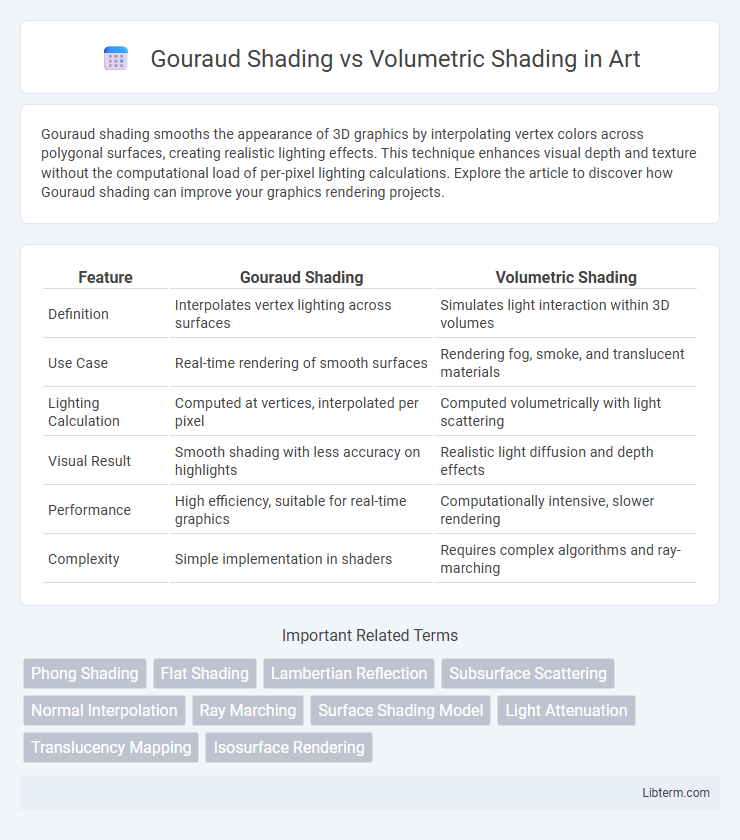Gouraud shading smooths the appearance of 3D graphics by interpolating vertex colors across polygonal surfaces, creating realistic lighting effects. This technique enhances visual depth and texture without the computational load of per-pixel lighting calculations. Explore the article to discover how Gouraud shading can improve your graphics rendering projects.
Table of Comparison
| Feature | Gouraud Shading | Volumetric Shading |
|---|---|---|
| Definition | Interpolates vertex lighting across surfaces | Simulates light interaction within 3D volumes |
| Use Case | Real-time rendering of smooth surfaces | Rendering fog, smoke, and translucent materials |
| Lighting Calculation | Computed at vertices, interpolated per pixel | Computed volumetrically with light scattering |
| Visual Result | Smooth shading with less accuracy on highlights | Realistic light diffusion and depth effects |
| Performance | High efficiency, suitable for real-time graphics | Computationally intensive, slower rendering |
| Complexity | Simple implementation in shaders | Requires complex algorithms and ray-marching |
Introduction to 3D Shading Techniques
Gouraud Shading is a vertex-based technique that smooths lighting across polygon surfaces by interpolating vertex colors, ideal for real-time rendering with moderate computational cost. Volumetric Shading simulates light interaction within translucent materials, capturing effects like scattering and absorption to enhance realism in fog, smoke, and clouds. These 3D shading techniques differ fundamentally in approach and application, with Gouraud optimizing surface shading and Volumetric emphasizing volumetric light behavior.
Overview of Gouraud Shading
Gouraud Shading is a computer graphics technique that interpolates vertex colors across polygon surfaces to create smooth lighting effects and realistic shading. It calculates lighting at polygon vertices and interpolates the color values for pixels inside the polygon, reducing computational complexity compared to per-pixel shading methods. This method is effective for rendering curved surfaces with smooth gradients but can produce artifacts such as Mach bands in high-frequency lighting variations.
Overview of Volumetric Shading
Volumetric shading simulates the interaction of light with semi-transparent materials, such as smoke, fog, or clouds, by calculating light absorption, scattering, and emission within a volume. Unlike Gouraud shading, which interpolates vertex colors on polygon surfaces for smooth lighting effects, volumetric shading provides realistic rendering of participating media with complex light behavior throughout a 3D space. Techniques like ray marching and volumetric ray tracing are commonly employed to achieve accurate volumetric lighting and shadows in real-time graphics and visual effects.
Core Principles and Algorithms
Gouraud shading calculates vertex colors using surface normals and interpolates these colors across polygons, employing a fast algorithm ideal for smooth shading on low-polygon models. Volumetric shading, in contrast, simulates light interaction within a 3D volume by tracing rays through voxels, applying transfer functions and scattering models to capture complex effects like translucency and depth. The core algorithmic difference lies in Gouraud's focus on polygonal mesh interpolation versus volumetric shading's integral computation over volumetric data fields.
Visual Outcomes and Realism
Gouraud Shading smooths surface lighting by interpolating vertex colors, producing efficient but sometimes overly flat visuals that lack depth and detail in complex lighting conditions. Volumetric Shading simulates light interaction within translucent materials like fog, smoke, or clouds, yielding highly realistic effects with depth, scattering, and absorption phenomena. This makes Volumetric Shading superior for immersive environments requiring accurate light diffusion and atmospheric realism.
Performance and Computational Demands
Gouraud shading offers faster rendering performance by calculating vertex lighting and interpolating colors across surfaces, reducing computational demands compared to volumetric shading. Volumetric shading requires intensive computations to simulate light interaction within three-dimensional volumes, resulting in higher GPU load and slower rendering times. For real-time applications, Gouraud shading is more efficient, whereas volumetric shading excels in realism at the cost of increased processing power.
Applications in Modern Graphics
Gouraud shading is primarily used in real-time rendering for smooth color transitions on 3D polygon surfaces, making it ideal for video games and interactive applications where performance is critical. Volumetric shading excels in simulating realistic light scattering within translucent materials, commonly applied in medical imaging, atmospheric effects, and volumetric fog in film production. Both techniques contribute significantly to modern graphics by balancing computational efficiency and visual realism depending on the application's requirements.
Advantages and Limitations
Gouraud shading efficiently smooths polygonal surface lighting by interpolating vertex colors, offering fast rendering and reduced computational load ideal for real-time applications; however, it struggles with accurately displaying specular highlights and fine details due to linear interpolation limitations. Volumetric shading excels in simulating light interactions within translucent materials, enabling realistic renderings of fog, smoke, and clouds by accounting for light absorption and scattering, but it demands significantly higher computational resources and complexity. Choosing between the two depends on the specific requirements for rendering accuracy versus performance, with Gouraud shading favored for speed and Volumetric shading for photorealistic volumetric effects.
Industry Use Cases and Comparisons
Gouraud shading excels in real-time applications such as video games and interactive simulations due to its computational efficiency and smooth color interpolation across polygon surfaces. Volumetric shading is favored in medical imaging, scientific visualization, and visual effects industries where rendering translucent materials, light scattering, and volumetric phenomena like smoke or clouds provide crucial depth and realism. While Gouraud shading prioritizes speed and surface color gradients, volumetric shading delivers complex light interactions within 3D volumes, making it essential for industries demanding detailed volumetric data representation.
Choosing the Right Shading Technique
Choosing the right shading technique depends on the desired visual outcome and computational resources available. Gouraud Shading offers smooth color transitions on polygon surfaces through vertex color interpolation, ideal for real-time rendering with low computational overhead. Volumetric Shading, on the other hand, simulates light interaction within three-dimensional volumes, producing realistic effects like fog, smoke, and subsurface scattering but requires higher processing power for accurate light absorption and scattering calculations.
Gouraud Shading Infographic

 libterm.com
libterm.com